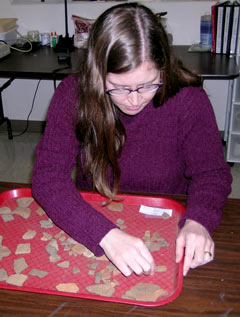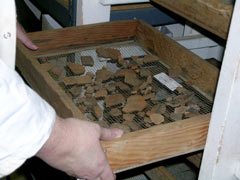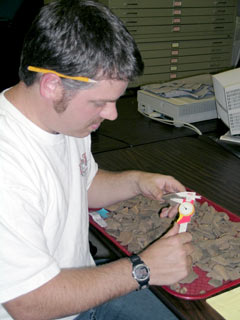



The first thing an archaeologist does in the lab is to assess the collection to ascertain the condition of the artifacts. Since we want to preserve the artifacts, we identify those items that are very fragile and unable to survive excessive handling. Next, any materials that need special handling, such as bone tools or shell beads, are separated from the rest of the material. Key information, known as the provenience, tells researchers exactly where each artifact was located in the ground, including not only its horizontal location on the site grid, but also its vertical depth. This information also includes the date the artifact was excavated and by whom. The provenience is kept with the artifact at all times, from excavation, to lab analysis, to final curation (permanent safe storage). This is critical because knowing where an artifact comes from can often help us determine who used it, when it was used, and why and how it was used.
After archaeologists have isolated all the fragile artifacts, many are stabilized by either wrapping in special paper or being impregnated with a special mixture of polyvinyl resin and acetone known as polyvinyl acetate or PVA. This is particularly good for bone artifacts because the PVA soaks into the pores and crevices and makes the artifact safe to handle and study. Animal bone can tell a very important part of the story of the people who lived at a site and the animals that were part of their diet and environment. Not all bone is fragile enough to require this treatment. Often bone collections from sites are sent to be studied by zooarchaeologists, archaeologists who can identify the species, gender, and age of the animal, and determine the amount of meat represented by the various bones, along with information about butchering, hunting, seasonality, and animal rearing practices. The bone preservation at the Bartow Leake sites is good. Archaeologists have recovered mammals, fowl, and fish bones (and scales on the latter).
Archaeologists in the lab wash artifacts that are already stable and don’t require special handling. They place the cleaned artifacts on drying racks in the wet lab, making sure to keep the provenience information with the associated artifacts. In many cases this is the first chance researchers have to actually see what they have been excavating during the last few months. Next, the artifacts are transferred to sorting trays and the real analytical work begins. Archaeologists examine each artifact and determine what it is made of and what its function may have been when it was in use. They carefully examine ceramic fragments (sherds) to determine what type of material (temper) was mixed in with the clay when Native Americans made the pots. Archaeologists can often link tempering agents to discrete time periods when the pottery was made. Surface decoration is one of the most important factors in determining the age of the pottery and what culture made it. Just as many modern people have the latest kitchen ware in their cupboards, Native Americans also enjoyed changing styles. In addition to fashion, decoration may also indicate trade networks and religious beliefs. Archaeologists continue to study pottery designs in an effort to understand these ideas from over 2,000 years ago.
Stone tools are also very good indicators of when Native Americans used a site. Tool technology changed over time, reflecting changes in environment, diet, and activities. For example, a greater reliance on smaller, faster game animals resulted in a decrease in the size of spear points. This decrease continued with the invention of the bow and arrow, and small arrowheads. Studying spear points, stone knives, arrowheads, drills, scrapers and other stone tools gives researchers very accurate information about how Native Americans hunted and how they fashioned items out of wood, bone, shell, and plant material. Archaeologists record information in the lab about stone tools, including shape, method of manufacture, and material in order to identify when and where it was made, how it was used, and any other useful information. Archaeologists in the lab measure the dimensions of stone tools using calipers to determine length, width, and thickness. They examine the tools for evidence of wear, re-sharpening and other indicators of use.
After the artifacts have been examined and everything we can determine about them at this point in time is known, all the measurements, total counts, and other statistics generated by the study are entered into a database so that they can be sorted and quantified by archaeologists. This allows them to answer specific research questions about the people using the site and gain a better picture of life in the past there. They use this data to write a report summarizing the site, excavation results, and an interpretation of these results. The data allows archaeologists now and in the future to reconstruct the site and answer new questions.
Seeds, nuts and pollen can survive in the soil for thousands of years and researchers have been able to learn many new and exciting things about prehistoric people through the study of plants. Archaeologists take samples of soil from certain parts of sites that have not been disturbed by later plowing, digging, or other activity. Often soil samples are taken from features such as trash pits. These soils are sent to specialists, such as ethnobotanists and palynologists. Ethnobotanists examine the soils for burned seeds, charcoal and other plant remains in order to determine what plants Native Americans were eating, gathering, growing, or using for dyes, basketry, fiber, fabric, and housing. We now know, for example, when certain plants were first cultivated and when people remained in a place to grow food rather than hunt and gather.
After completion of artifact analysis, archaeologists put the artifacts, by specific provenience, into polyurethane zip bags with acid free archival quality paper tags inside. The tags record everything about the object, including where it came from, what it is, and from what material it is made. These bags are then placed into larger bags containing all the materials collected from a specific provenience. The bags are then arranged in boxes for permanent, safe, and accessible storage (curation). Artifacts are curated or stored in a safe place for future researchers. Curation keeps artifacts from different proveniences from getting mixed together. It also keeps them free from temperature changes, fire, pests, and thieves. Curation allows the artifacts, notes, photographs, scaled drawings, and maps to stay together as a collection for future study. There are so many new techniques and new technologies developing every day. Archaeologists in years to come will be able to apply these new methods to reexamine the materials being excavated today and potentially learn much more about the who, what, when and where of the people who lived at the Leake Site. Curation also allows artifacts and their provenience information to be safely stored for use in future museum exhibits.



